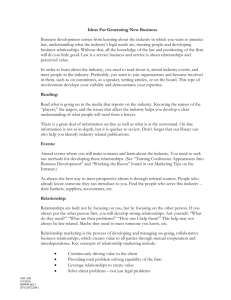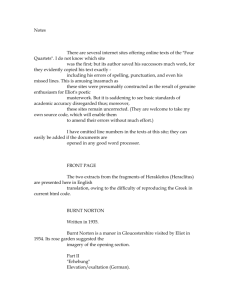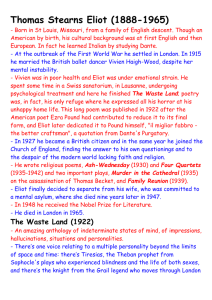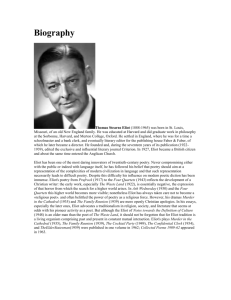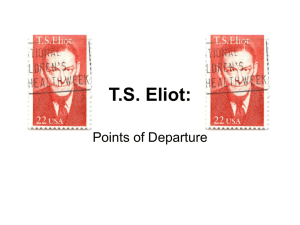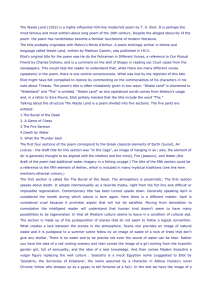Lesson 10-1 The Modern Secular World - The Struggle to
advertisement
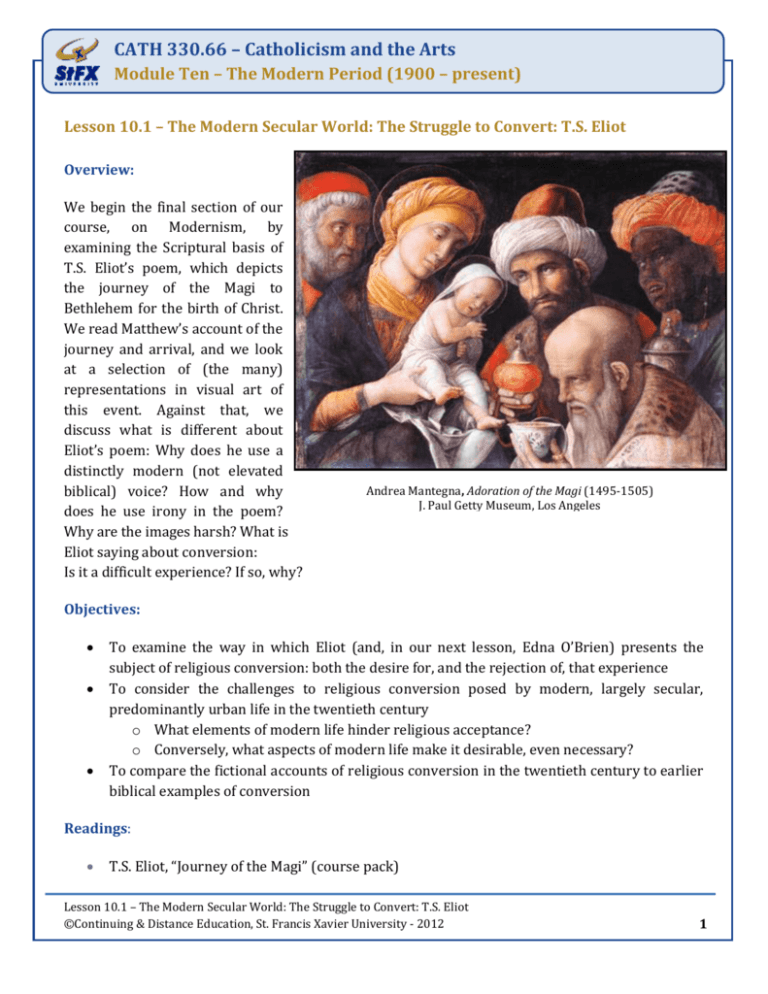
CATH 330.66 – Catholicism and the Arts Module Ten – The Modern Period (1900 – present) Lesson 10.1 – The Modern Secular World: The Struggle to Convert: T.S. Eliot Overview: We begin the final section of our course, on Modernism, by examining the Scriptural basis of T.S. Eliot’s poem, which depicts the journey of the Magi to Bethlehem for the birth of Christ. We read Matthew’s account of the journey and arrival, and we look at a selection of (the many) representations in visual art of this event. Against that, we discuss what is different about Eliot’s poem: Why does he use a distinctly modern (not elevated biblical) voice? How and why does he use irony in the poem? Why are the images harsh? What is Eliot saying about conversion: Is it a difficult experience? If so, why? Andrea Mantegna, Adoration of the Magi (1495-1505) J. Paul Getty Museum, Los Angeles Objectives: To examine the way in which Eliot (and, in our next lesson, Edna O’Brien) presents the subject of religious conversion: both the desire for, and the rejection of, that experience To consider the challenges to religious conversion posed by modern, largely secular, predominantly urban life in the twentieth century o What elements of modern life hinder religious acceptance? o Conversely, what aspects of modern life make it desirable, even necessary? To compare the fictional accounts of religious conversion in the twentieth century to earlier biblical examples of conversion Readings: T.S. Eliot, “Journey of the Magi” (course pack) Lesson 10.1 – The Modern Secular World: The Struggle to Convert: T.S. Eliot ©Continuing & Distance Education, St. Francis Xavier University - 2012 1 CATH 330.66 – Catholicism and the Arts Module Ten – The Modern Period (1900 – present) 10.1.1. Modernism: What is it? T.S. Eliot was writing in the High Modernist period: the era following World War I when writers sought to radically alter all conventional aspects of literature, in both content and form. In content, writers were newly addressing the devastating aftermath of the Great War, the complexity of urban life (its beauty and its ugliness), the fascination with human psychology, troubling experiences of social isolation, and deepening religious scepticism (where is God in the midst of war?). In form, writers felt that literature needed new aesthetic principles that dispensed with conventional expectations; they sought to alter our reading experience in the way that World War I made a radical break in human history: certainty, of any sort, was no longer assured. In fiction, James Joyce and Virginia Woolf introduced stream-of-consciousness narration, which traces the fluctuations of a character’s mind, in all of its vicissitudes, on an ordinary day. This replaces a distanced, objective narrator who serves the reader by filtering, selecting from, and giving shape to the random details of daily life; instead, the subject, now, is the fluctuating human mind, and this interior emphasis precludes the construction of a conventional, external plot: art, now, conforms to life, not the other way around. A “story” is just a slice of life, not a perfectly-polished, formallycrafted aesthetic object. Changes were occurring in poetry, too, and T.S. exemplifies this. He, with others, introduced a more elliptical kind of verse—that is, writing that is full of gaps, so to speak: words are missing, transitions between thoughts are jarring, allusions are unexplained. Eliot offered a difficult, newly obscure, intellectual poetry (a long way from Wordsworth’s ideal of writing poetry for, and in the language, of common people). The complexity of T.S. Eliot, however, is that he did value tradition, as well. He studied the great writers of the past, including the metaphysical John Donne. As well, he revered religious tradition, which is remarkable, for a man driven to write of the ruined, secular “Waste Land” that the Great War left behind. Eliot’s “The Journey of the Magi” (1927) “The Journey of the Magi” is an explicitly Christian poem: it recounts the journey of the Magi to the birth of the Christ child. It is a Nativity poem. The poem alludes to this passage from Matthew. Matthew 2:1-12 In the time of King Herod, after Jesus was born in Bethlehem of Judea, wise men from the East came to Jerusalem, asking “Where is the child who has been born king of the Jews? For we observed his star at its rising, and have come to pay him homage.” When King Herod heard this, he was Lesson 10.1 – The Modern Secular World: The Struggle to Convert: T.S. Eliot ©Continuing & Distance Education, St. Francis Xavier University - 2012 2 CATH 330.66 – Catholicism and the Arts Module Ten – The Modern Period (1900 – present) frightened, and all Jerusalem with him; and calling together all the chief priests and scribes of the people, he inquired of them where the Messiah was to be born. They told him, “In Bethlehem of Judea; for so it has been written by the prophet” . . . .Then Herod secretly called for the wise men and learned from them the exact time when the star had appeared. Then he sent them to Bethlehem saying, “Go and search diligently for the child; and when you have found him, bring me world so that I may also pay him homage.” When they heard the king, they set out; and there, ahead of them, went the star that they had seen at its rising, until it stopped over the place where the child was. When they saw that the star had stopped, they were overwhelmed with joy. On entering the house, they saw the child with Mary his mother; and they knelt down and paid him homage. Then, opening their treasure chests, they offered him gifts of gold, frankincense, and myrrh. And having been warned in a dream not to return to Herod, they left for their own country by another road. Lorenzo Ghiberti, Adoration of The Magi (1403-24), Baptistry, Florence Lesson 10.1 – The Modern Secular World: The Struggle to Convert: T.S. Eliot ©Continuing & Distance Education, St. Francis Xavier University - 2012 3 CATH 330.66 – Catholicism and the Arts Module Ten – The Modern Period (1900 – present) Additionally, the poem addresses the subject of Christian conversion. The Magi, men from the East, encounter something new—Christ—which invites them to turn away from their pagan past: to die to the old and be born to the new. As Eliot depicts their experience, through the mind of one Magus, we learn of the difficulty of conversion: the strangeness and lack of certainty (the Magi do not know, as we do, 2,000 years later, the full story of Christ’s life, death, and resurrection—the affirmation of our salvation); and the challenge of living in a state of exile within their own homeland. The speaking Magus is dictating his experience to a scribe, years later; still, he cannot say with certitude whether he has encountered his own “Birth or Death.” The Nativity and the experience of conversion are intertwined subjects, clearly, and Eliot was prompted to write of this connectedness in the context of his own religious conversion, which occurred over a lengthy period of time and culminated, in 1927, in his baptism into the Anglican Church. That year, he declared himself a “classicist in literature” and an “Anglo-Catholic in religion.” This poem was written and published in 1927. After it, Eliot continued to write other poems that were explicitly religious. Eliot’s long spiritual quest was not an easy one, for he experienced his own depression and marital difficulties along the way. In both his personal life and his poetry, then, Eliot is poised between new and old: adhering to tradition, in thought, religion, and literature, while valuing Modernist developments in form; and shedding aspects of his biographical past, while acknowledging the “hard and bitter agony” of such a conversion. Literary Analysis and Study Questions A. Stanza by Stanza Think of the poem as structured in three parts. First, though, read the passage from Matthew’s gospel to which the whole poem alludes. Stanza 1: Journey 1. Lines 1-5: This quoted passage is another allusion. It comes from a Nativity sermon preached by Lancelot Andrews in 1622. The sermon exhorts Christians to endure the difficult journey towards Christ, even in miserable (English) winter. His text is critical of Christians who desire only comfort. Christianity demands hardship and sacrifice: triumphant salvation does not come to fruition without suffering. Why would Eliot choose this passage as his opening? Why has he modified it for his own purposes? This is a link to the full sermon, if you wish to read it. You will find our passage at the mid-point of the sermon. http://anglicanhistory.org/lact/andrewes/v1/sermon15.html Lesson 10.1 – The Modern Secular World: The Struggle to Convert: T.S. Eliot ©Continuing & Distance Education, St. Francis Xavier University - 2012 4 CATH 330.66 – Catholicism and the Arts Module Ten – The Modern Period (1900 – present) It was no summer Progresse. A cold coming they had of it, at this time of the yeare; just, the worst time of the yeare, to take a journey, and specially a long journey, in. The waies deep, the weather sharp, and daies short, the sunn farthest off in solstitio brumali, the very dead of Winter. All these difficulties they overcame, of a wearisome, irkson, troublesome, dangerous, unseasonable journey: And for all this, they came. And, came it cheerfully, and quickly. . . .They saw, and they came. . . .[T]hey tooke all these paines, made all this haste, that they might be there to worship Him, with all the possible speede they could. Our fashion is, to see and see again, before we stirre a foot: Specially, if it be to the worship of Christ. Come such a journey, at such a time? No: but fairely have put it off to the Spring of the yeare, till the dayes longer, and the waies fairer, and the weather warmer. . . .Our Epiphanie would (sure) have fallen in Easterweeke at the soonest. 2. Lines 6-20: Notice, here, how Eliot deviates from Lancelot’s sermon, adding a modern, colloquial language and flippant scepticism that is not characteristic of either Lancelot’s sermon or of Scripture. a. Content: Read these lines carefully. Why are the Magi complaining? What are there specific frustrations? Why does Eliot characterize them as impatient? Why do they dismiss as “folly”? Why do they not have faith, guided by the start, that is expressed in Matthew’s gospel? b. Form: Think about Eliot’s style. The speech is modern and colloquial, which doesn’t come close to Andrews’ sermon of Scripture. The expressions sound like statements that we hear today, especially when we, too, meeting challenging conditions when travelling. Why has Eliot modernized their voices, making the men seem contemporary? Is he suggesting that conversion, while difficult, is available to all, everywhere, and not just for the wise, privileged Magi from the East, in the year of Christ’s birth? Stanza II: Arrival 1. Again, the account seems odd. It lacks exclamation and reverence: “it was (you might say) satisfactory.” This contrasts Matthew quite starkly. a. What is different? Why are the Magi so understated? What accounts for their ignorance of the full significance of what they encounter? Lesson 10.1 – The Modern Secular World: The Struggle to Convert: T.S. Eliot ©Continuing & Distance Education, St. Francis Xavier University - 2012 5 CATH 330.66 – Catholicism and the Arts Module Ten – The Modern Period (1900 – present) 2. In setting, the poem shifts from difficult winter to temperate spring, and descends into a fertile valley. Still, they see signs (that we know from Scripture as being prophetic of life of Christ) but they do not recognize their significance; instead, they appear to be naturally part of the landscape that they pass through. Look carefully at the images: white horse (Revelation), three trees (Calvary), dicing for silver (Judas), wine skins (Christ’s miracle at Cana). a. Why is Eliot creating these two layers of meaning? Is he reconceptualizing the account from Scripture, adding realism and honesty: the Magi don’t recognize these signs because Christ hasn’t yet lived, suffered, died, and risen. We have that knowledge, only in hindsight. The Magi, then, are justifiably doubtful and hesitant and unknowing. This, Eliot suggests, is the reality of conversion, even for celebrated biblical figures and the uncertainty confronts all of us, too, in each daily conversion to sustain our faith in a stridently secular world. Stanza III: Return Home 1. In this final stanza, we recognize the poem as a dramatic monologue: an extended spoken dialogue by one character to a silent listener, in this case, one Magus to his scribe: “set down / This set down / This: . . . .” He desires to record the experience, years later, perhaps to make sense of it in doing so. His mind is still troubled, able only to ask questions but not to articulate answers: “were we led all that way for / Birth or Death?” a. What has the experience meant for the Magus? To be sure, he has experienced both birth (the child’s birth, and his own birth to a new religion) and death (his rejection of the old, and death to a comfortable familiar life). Why is he still unfulfilled? Is he now an awkward foreigner in his own land? Why does he desire “another death”? What “death,” literal or metaphoric, would that be? B. General Considerations: the Poem as a Whole 1. Irony: Think carefully about Eliot’s use of irony. While we have seen it used already (most notably, in Othello), irony is a characteristic of modern poetry: an expression of general angst and uncertainty in this era. a. Irony is, in simple terms, an incongruity or discrepancy. We have learned, already, the three types of irony in literature: verbal irony, irony of situation, and dramatic irony. Lesson 10.1 – The Modern Secular World: The Struggle to Convert: T.S. Eliot ©Continuing & Distance Education, St. Francis Xavier University - 2012 6 CATH 330.66 – Catholicism and the Arts Module Ten – The Modern Period (1900 – present) b. How does Eliot use irony? i. Consider the irony of situation: We expect the poem to align itself with Scripture, but it doesn’t, in neat terms. Details are omitted or altered, and a modern voice is given to the Magi. Why does Eliot dash our expectations? Why is the Magi’s experience not what we would expect? ii. Consider the dramatic irony: Eliot alters the time frame, creating an ironic gap between what the Magi know (that is, don’t know) and what we know, 2,000 years after the event, of Christ’s triumphant reign. In hindsight, we have no reason to question the hard journey. The Magi, in contrast, do not have the fullness of that perspective. As readers, then, we comprehend the complexity of the poem, if we are attentive to this dramatic irony—the temporal incongruity. Our knowledge exceeds that of the Magi. Eliot has created two time frames and two sets of knowledge, which don’t cohere into one. Again, why does Eliot do this? Is he striving for honesty and realism, as we noted earlier: the difficulty of conversion, even our own daily conversions? We can intuit Providence—a divinely ordered pattern to our lives that God wills, in His own time—but we can’t discern the meaning of life’s events absolutely. We “see in a glass darkly.” Faith is difficult. 2. Oxymoron: How does the poem exemplify this figurative device, too? We encountered it earlier, as well, in “The Dream of the Rood” and in our Medieval Lyrics. It is the use of language to express a contradiction that is, nevertheless, true. How can the Magus claim that “I had seen birth and death”? He says, “this Birth was / Hard and bitter agony for us, like Death, our death.” What does he mean? How can the experience consist of both? Why is Christianity so rife with paradoxes? 10.1.2. Activity for Blackboard Discussion Place the poem within the art historical tradition. Go to the Web Gallery of Art. Look at the many paintings depicting the subject of the journey and arrival of the Magi at the scene of the Nativity. (Typing “Magi” into title is a good way to retrieve multiple images.) Familiarize yourself with how (and think about why) this subject is such a widely-depicted one in art. http://www.wga.hu/index1.html 1. Look carefully at the three paintings below, which I have selected from that database. Select ONE of them. Discuss it with the class. What is the relationship of the painting to Eliot’s poem and to Matthew’s account in Scripture? Are they similar or different? Does the painting come closer to the poem or to Scripture, or both? Why? Lesson 10.1 – The Modern Secular World: The Struggle to Convert: T.S. Eliot ©Continuing & Distance Education, St. Francis Xavier University - 2012 7 CATH 330.66 – Catholicism and the Arts Module Ten – The Modern Period (1900 – present) Pieter Brueghel, Pieter the Younger Adoration of the Magi (c. 1600) Museo Correr, Venice Lesson 10.1 – The Modern Secular World: The Struggle to Convert: T.S. Eliot ©Continuing & Distance Education, St. Francis Xavier University - 2012 8 CATH 330.66 – Catholicism and the Arts Module Ten – The Modern Period (1900 – present) Fra Angelico, Adoration of the Magi (1423-24), Abegg-Stiftung, Bern Lesson 10.1 – The Modern Secular World: The Struggle to Convert: T.S. Eliot ©Continuing & Distance Education, St. Francis Xavier University - 2012 9 CATH 330.66 – Catholicism and the Arts Module Ten – The Modern Period (1900 – present) Giotto di Bondone No. 18 Scenes from the Life of Christ: 2. Adoration of the Magi (1304-06) Cappella Scrovegni (Arena Chapel), Padua Lesson 10.1 – The Modern Secular World: The Struggle to Convert: T.S. Eliot ©Continuing & Distance Education, St. Francis Xavier University - 2012 10


